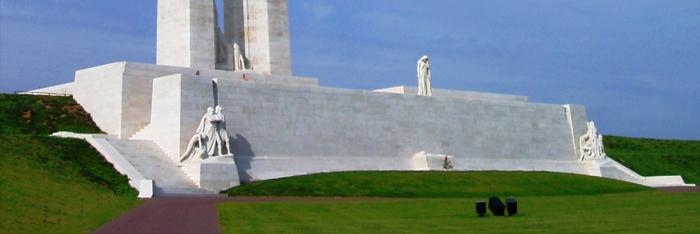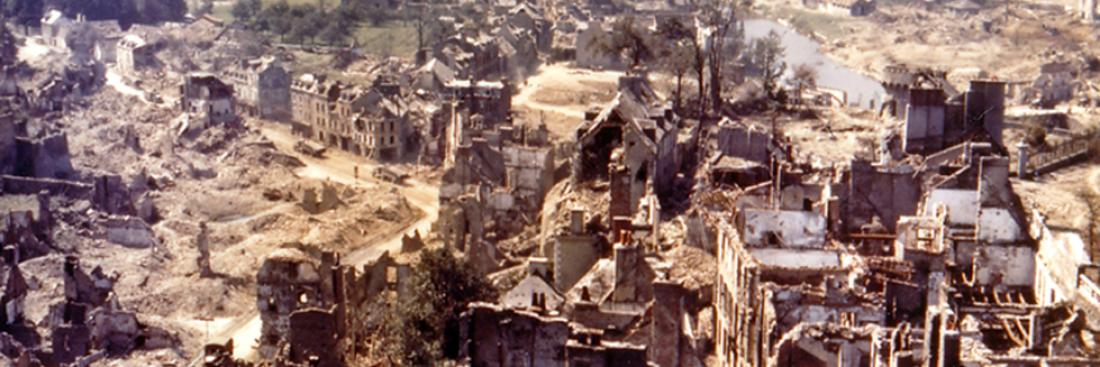
Vue du parc mémorial canadien de Vimy. Source : Licence Creative Commons. Libre de droit
The Canadian Memorial of Vimy
The Canadian Memorial of Vimy, stands as an impressive tribute that Canada paid to all those who served their country in fighting or gave their lives during the First World war. It majestically overhangs the Douai plain and the mining area at the foot of the Artois hills. It indicates the location of the operation of which the Canadians are proudest, during the Second World war. It represents a homage to all those who fought during four years for their country and in particular to all those who paid with their lives.
On the pedestal of the Monument the following words are engraved:
TO THE VALOUR OF THEIR COUNTRYMEN IN THE GREAT WAR AND IN MEMORY OF THEIR SIXTY THOUSAND DEAD, THIS MONUMENT IS RAISED BY THE PEOPLE OF CANADA.
Inscribed on the ramparts of the Memorial are the names, of a thousand two hundred and twenty five Canadian soldiers who were posted "missing and presumed dead" in France. The soil of the park of this battlefield, measures a surface of 91,18 hectares (two hundred and fifty acres) and "is a gift of the French nation to the Canadian people ", as a plaque indicates at the entrance of the Monument. The Memorial rests on a bed of eleven thousand tons of concrete and masonry. For the pylons and the sculptures five thousand five hundred tons of limestone have been used and brought to the site from Yugoslavia. The construction of this gigantic work started in 1925. The Canadian National Memorial of Vimy was unveiled eleven years later by King Eduard VIII on July 26th 1936.
The park surrounding the Vimy Memorial is the work of horticultural experts. It is adorned with many Canadian trees and shrubs, in order to remember the forests and woods of the country. The memorial is surrounded by a green hillside that leads to a vast wood. At the sight of the perfectly restored trenches and tunnels, the visitor can imagine the enormous task the Canadian army corps had to achieve during this historical morning, many years ago.
November 9th 1997, representatives of the Canadian government proceed with the inauguration of the Interpretation Centre of the Canadian Memorial in Vimy. This Monument became one of the only national sites of Canada situated in a foreign country. The Centre is a complement to the guided tour of the tunnels and the trenches. The visitors can better understand the sense and importance of this Memorial. Furthermore they can better place the history of the Vimy Battle in the context of the Canadian participation at the First World war. The war, day after day, Vimy, a well planed battle; Vimy : the captured crest; and Canada remembers the war.
Thanks to photographic reproductions and banners (brown and ochre colors), artifacts, maps, graphic representations, an audiovisual multimedia presentation, explanatory texts, the exhibition allows the visitors to live the atmosphere which reigned in that period. The Interpretation Centre of the Canadian Memorial in Vimy is situated 200 meters from the Canadian Memorial in Vimy, near the main parking area. The Canadian Memorial in Vimy is located approximately 10 Km from Arras. Very close to Thélus, the Canadian cemetery and the monument honouring the Canadian artillery is situated in Zivy Crater. Here, a mine explosion dug a crater in the ground.
Monument and Memorial Park of Canada at Vimy
62580 Vimy
Tel : 03 21 50 68 68
Fax : 03 21 58 58 34
E-mail : Vimy.Memorial@vac-acc.gc.ca
Open every day except 25 December and 1 January From May 1 to October 31 :
10H à 18H November 1 to April 30 : 9H à 17H
